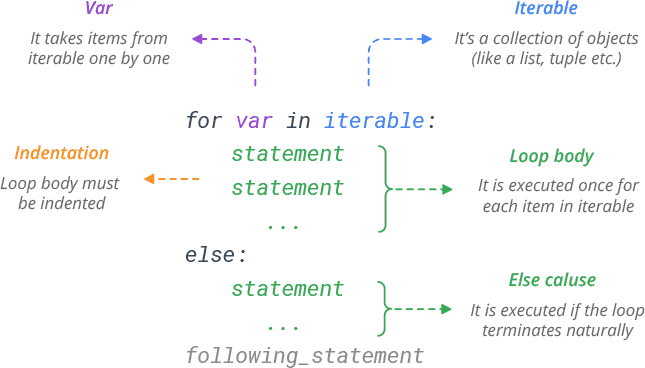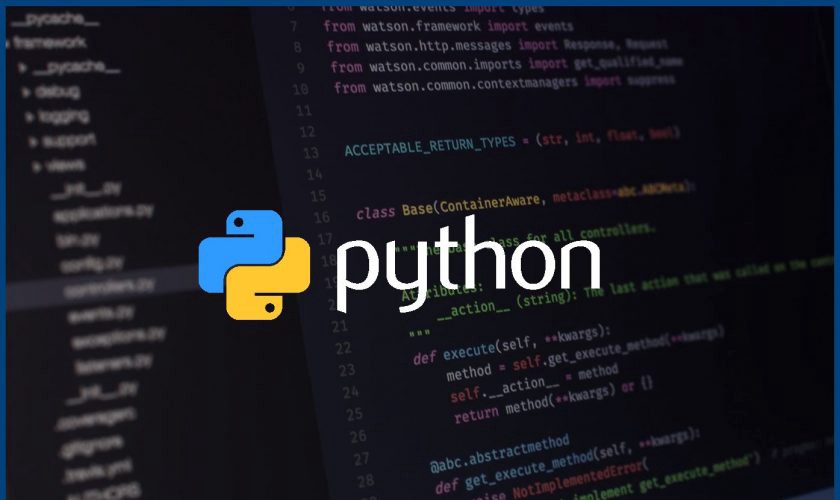Python for Loop
The for statement in Python is a bit different from what you usually use in other programming languages.
Rather than iterating over a numeric progression, Python’s for statement iterates over the items of any iterable (list, tuple, dictionary, set, or string). The items are iterated in the order that they appear in the iterable.
Syntax
Here’s the syntax of the for statement:

Basic Examples
# Iterate through a list
colors = ['red', 'green', 'blue', 'yellow']
for x in colors:
print(x)
# Prints red green blue yellow# Iterate through a string
S = 'python'
for x in S:
print(x)
# Prints p y t h o nBreak in for Loop
Python break statement is used to exit the loop immediately. It simply jumps out of the loop altogether, and the program continues after the loop.
# Break the loop at 'blue'
colors = ['red', 'green', 'blue', 'yellow']
for x in colors:
if x == 'blue':
break
print(x)
# Prints red greenContinue in for Loop
The continue statement skips the current iteration of a loop and continues with the next iteration.
# Skip 'blue'
colors = ['red', 'green', 'blue', 'yellow']
for x in colors:
if x == 'blue':
continue
print(x)
# Prints red green yellowElse in for Loop
Python allows an optional else clause at the end of a for loop. The else clause will be executed if the loop terminates naturally (through exhaustion).
colors = ['red', 'green', 'blue', 'yellow']
for x in colors:
print(x)
else:
print('Done!')
# Prints red green blue yellow
# Prints Done!If the loop terminates prematurely with break, the else clause won’t be executed.
colors = ['red', 'green', 'blue', 'yellow']
for x in colors:
if x == 'blue':
break
print(x)
else:
print('Done!')
# Prints red greenrange() function in for loop
If you need to execute a group of statements for a specified number of times, use built-in function range().
The range(start,stop,step) function generates a sequence of numbers from 0 up to (but not including) specified number.
# Generate a sequence of numbers from 0 6
for x in range(7):
print(x)
# Prints 0 1 2 3 4 5 6range() provides a simple way to repeat an action a specific number of times.
# Print 'Hello!' three times
for x in range(3):
print('Hello!')
# Prints Hello!
# Prints Hello!
# Prints Hello!The range starts from 0 by default. But, you can start the range at another number by specifying start parameter.
# Generate a sequence of numbers from 2 to 6
for x in range(2, 7):
print(x)
# Prints 2 3 4 5 6You can generate a range of negative numbers as well.
for x in range(-5,0):
print(x)
# Prints -5 -4 -3 -2 -1The range increments by 1 by default. But, you can specify a different increment by adding a step parameter.
# Increment the range with 2
for x in range(2, 7, 2):
print(x)
# Prints 2 4 6Nested for Loop
A loop inside another loop is called a nested loop.
# Flatten a nested list
list = [[1, 2, 3],[4, 5, 6],[7, 8, 9]]
for sublist in list:
for number in sublist:
print(number)
# Prints 1 2 3 4 5 6 7 8 9Access Index in for Loop
To iterate over the indices of a sequence, you can combine range() and len() as follows:
colors = ['red', 'green', 'blue']
for index in range(len(colors)):
print(index, colors[index])
# Prints 0 red
# Prints 1 green
# Prints 2 blueHowever, in most such cases it is convenient to use the enumerate() function.
colors = ['red', 'green', 'blue']
for index, value in enumerate(colors):
print(index, value)
# Prints 0 red
# Prints 1 green
# Prints 2 blueUnpacking in a for loop
Below for loop does a multiple assignment (unpack the current tuple) each time through the loop.
# Tuple unpacking
T = [(1, 2), (3, 4), (5, 6)]
for (a, b) in T:
print(a, b)
# Prints 1 2
# Prints 3 4
# Prints 5 6Likewise, you can iterate through both keys and values in a dictionary.
# Dictionary unpacking
D = {'name': 'Bob', 'age': 25}
for x, y in D.items():
print(x, y)
# Prints age 25
# Prints name BobModify a List While Iterating
Don’t alter mutable objects while looping on them. It may create an infinite loop.
# infinite loop
colors = ['red', 'green', 'blue']
for x in colors:
if x == 'red':
colors.insert(0, 'orange')
print(colors)It is recommended that you first make a copy. The slicing operator makes this especially convenient.
colors = ['red', 'green', 'blue']
for x in colors[:]:
if x == 'red':
colors.insert(0, 'orange')
print(colors)
# Prints ['orange', 'red', 'green', 'blue']Looping Through Multiple Lists
Using built-in zip() function you can loop through multiple lists at once.
# Loop through two lists at once
name = ['Bob', 'Sam', 'Max']
age = [25, 35, 30]
for x, y in zip(name, age):
print(x, y)
# Prints Bob 25
# Prints Sam 35
# Prints Max 30
Python Example for Beginners
Two Machine Learning Fields
There are two sides to machine learning:
- Practical Machine Learning:This is about querying databases, cleaning data, writing scripts to transform data and gluing algorithm and libraries together and writing custom code to squeeze reliable answers from data to satisfy difficult and ill defined questions. It’s the mess of reality.
- Theoretical Machine Learning: This is about math and abstraction and idealized scenarios and limits and beauty and informing what is possible. It is a whole lot neater and cleaner and removed from the mess of reality.
Data Science Resources: Data Science Recipes and Applied Machine Learning Recipes
Introduction to Applied Machine Learning & Data Science for Beginners, Business Analysts, Students, Researchers and Freelancers with Python & R Codes @ Western Australian Center for Applied Machine Learning & Data Science (WACAMLDS) !!!
Latest end-to-end Learn by Coding Recipes in Project-Based Learning:
Applied Statistics with R for Beginners and Business Professionals
Data Science and Machine Learning Projects in Python: Tabular Data Analytics
Data Science and Machine Learning Projects in R: Tabular Data Analytics
Python Machine Learning & Data Science Recipes: Learn by Coding
R Machine Learning & Data Science Recipes: Learn by Coding
Comparing Different Machine Learning Algorithms in Python for Classification (FREE)
Disclaimer: The information and code presented within this recipe/tutorial is only for educational and coaching purposes for beginners and developers. Anyone can practice and apply the recipe/tutorial presented here, but the reader is taking full responsibility for his/her actions. The author (content curator) of this recipe (code / program) has made every effort to ensure the accuracy of the information was correct at time of publication. The author (content curator) does not assume and hereby disclaims any liability to any party for any loss, damage, or disruption caused by errors or omissions, whether such errors or omissions result from accident, negligence, or any other cause. The information presented here could also be found in public knowledge domains.

